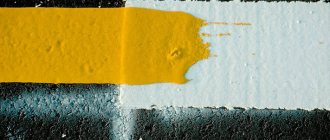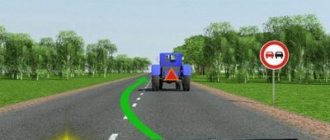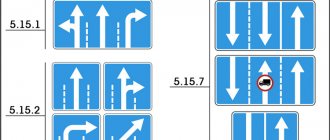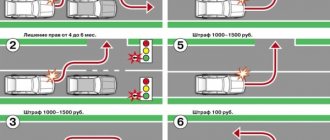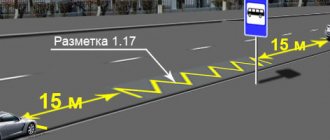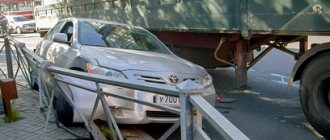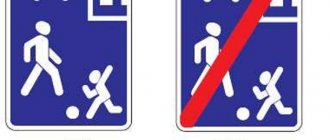In addition to the usual markings that are applied to the roadway, there are vertical markings. From the name it is clear in what spatial position it is located. But why do road workers complicate traffic rules? Are ordinary markings and road signs not enough? It turns out that no. This element of sign instructions in the rules of the road is of a warning nature, designed to attract special attention from the driver. Let's still figure out for what purposes our roads are marked with such unusual markings.
Vertical markings 2.1.1 - 2.1.3
Vertical marking 2.1 is an alternating black and white shading at an angle of 45 degrees, as in the figure below.
Markings 2.1.1-2.1.3 are used to designate vertical elements (surfaces) of road structures (bridge supports, lighting poles, overpasses, ends of parapets and other obstacles located within the curb) when these elements pose a danger to moving vehicles.
An example of vertical marking 2.1 against the background of road infrastructure is in the picture below (on light poles).
Markings 2.1.1 and 2.1.3 are applied to a structure (obstacle), located respectively to the left or right of the roadway, markings 2.1.2 - if it can be driven around on both sides.
Why do you need vertical markings?
Vertical road marking lines are used to paint road objects in order to inform the driver of approaching danger. As the vehicle moves, it encounters elements of overpasses, overpasses, tunnels and other structures that are located very close to the roadway. If during the day such supports can be seen long before approaching them, then at night they can often be invisible to the human eye.
In order to highlight such structures, this marking is used. Traffic regulations specifically determine the order of designation of all road objects that the driver may encounter along the entire route.
Objects requiring designation.
- Support columns for bridges, overpasses and overpasses.
- Curbs and bollards that enclose traffic islands.
- Side fencing elements of the road.
- Lamp post supports.
- Trees, as well as other elements or parts thereof, which are located closer than one meter from the edge of the roadway.
Each object that is located closer than 1 meter from the roadway must be marked with a special type of vertical marking defined in the traffic rules. Such elements are indicated by painting them with reflective paint. If, due to certain properties of the object, it is impossible to paint it, then a sheet of galvanized metal is painted, or a plastic picture is used.
Vertical marking 2.2
Vertical marking 2.2 is a vertical black and white shading (alternating) along the lower span of structures located above the road.
Marking 2.2 is used to mark the lower edge of the spans of bridge structures and tunnel portals located at a height of less than 5 meters. High spans (more than 5 m) are not marked with markings.
Vertical marking 2.2 is applied above the middle of each lane along which movement is carried out towards the structure, but it can also be applied along the entire width of the passing span for better visibility.
The picture below shows an example of applying marking 2.2 on the bridge superstructure.
Span height is important primarily for drivers of heavy-duty vehicles transporting bulky cargo, the dimensions of which go beyond the usual.
Regulatory regulation
Application parameters, as well as the dimensions of vertical marking stripes, are determined by GOST 13508-74. Road markings”, as well as “GOST 23457-86. Technical means of organizing traffic."
These two documents fully describe all the requirements for applying vertical markings to road facilities:
- line thickness;
- tilt angle;
- procedure for use and installation;
- use of reflective paint and elements;
- installation locations, etc.
Traffic rules indicate links to state standards that are valid at the time of their preparation. This makes it possible to avoid ambiguity in understanding the rules, and to ensure strict compliance by all officials with the requirements for handling vertical markings.
Post Views: 14
Vertical marking 2.3
Vertical marking 2.3 is a horizontal, alternately black and white shading, as in the figure below. This shading is applied to round pedestals.
Marking 2.3 is used to designate round bollards in cases where they are located on dividing strips, on guide islands raised above the roadway or raised traffic islands. The role of the round bollard in these cases is to indicate an obstacle.
Near the striped bollards, mandatory “Avoid obstacles” signs are usually installed, which show the possible direction of detour.
In recent years, there are fewer and fewer round bollards on the roads; they are being replaced by yellow plastic bollards and (or) signs 8.22.1 - 8.22.3 “Obstacle”.
A complete list of numbers and images of marking lines on the website is available in Appendix 2 of the Traffic Regulations.
Navigation through a series of articles<< Horizontal layout 1.24 - 1.25Vertical layout 2.4 - 2.7 >>
Types of vertical markings
Certain vertical markings of traffic rules are applied to various elements of the road infrastructure. For convenience, existing State Standards, as well as current traffic rules, have adopted a single numbering of symbols.
2.1 – applied to the vertical parts of automotive components. Usually these are support posts of overpasses or bridges, supports of bridge barriers. This designation applies to elements that extend in their parts into a meter zone from the edge of the roadway, or from horizontal road markings. If the designated object is massive, only part of it is painted: 0.5 meters in width and up to 2 meters in height.
This marking has varieties that are determined by indicating the direction to avoid the obstacle. So, right-hand, left-hand, and also a detour on both sides can be indicated.
2.2 – indicates the upper limit of the span. It can be found where the distance from the upper edge of the road to the lower edge of the artificial structure is less than five meters. These can be the lower parts of overpass spans, the upper boundaries of tunnels, as well as other elements that are located directly above the roadway.
The marking element is made in the form of alternating vertical black and white stripes. It is installed above the middle of the traffic lane or a solid line above the entire surface of the roadway.
2.3 – indicated in the form of horizontal alternating white and black stripes. Concrete columns called pedestals are painted with it. These posts are installed at the beginning of the dividing strip, as well as in the area of traffic islands.
Road markings numbered 2.1 – 2.3 are applied directly to the designated element. If the road situation does not allow the installation of lighting devices, then it is applied with a special paint that is reflected in the headlights. If it is impossible to paint the element itself, a pre-painted road sign is attached to it.
2.4 – applied to boundary posts or sign posts. It can also be found on the supports of road fences. It is similar to markup number 2.1. The difference is one oblique stripe on the column. The strip is tilted towards the roadway. This is done to mark the edge of the road.
2.5 – applied to the fence along the road. Such a fence is installed right at the edge of the road surface in especially dangerous places. In this case, the length of the section on which black and white stripes are depicted must be at least 10 meters.
Most often, this designation can be found on small-radius road turns, or in places where there is a steep slope behind an almost non-existent shoulder. It is also present at all bridge crossings. In general, this marking indicates to the driver the places where there is danger behind the road fence.
2.6 – performed as a straight solid line. It is applied in all other cases, except for cases in which marking 2.5 is required.
2.7 - mainly applied to curbs. It marks the boundaries of sidewalks, safety islands and other elements that, due to their design, rise above the roadway. In addition, it is used to designate places where vehicle traffic is allowed strictly in a straight direction, without the possibility of moving to the side of the road. The curb application method, as well as when painting traffic islands, differs.
Purpose of vertical markings on the road
Vertical markings have the following feature, which is the fact that they are applied to vertically located objects, and not to horizontal ones, so the car owner will not be able to drive on them. It’s worth starting with the fact that you can encounter such markings on the road much less frequently than horizontal ones. The most common places for its application are objects located near the road that are in a vertical position. The reason for its application is that such objects may be unsafe for traffic. The main feature of this type of marking is that, if available, no requirements are imposed on drivers, that is, their purpose will only be a warning about danger. Despite the fact that penalties for violating the requirements of such markings should not be imposed, if a collision with such an object occurs, the car can suffer serious damage.
Varieties. Before we start talking about varieties, I would like to note that memorizing them is not at all mandatory. The main rule that the driver must learn is: “it is forbidden to touch any part of the car.” This means that if such markings are found on the road, it is best to carefully drive around them. It's no secret that the reason for this is the application of such markings on concrete structures; encountering them will not bring positive consequences to the car.
Marking. The first three varieties of this marking are applied, as mentioned above, to vertical structures. But the fourth one is for horizontal spans of bridges and overpasses. Separately, it is worth noting that such 2.2 markings are of no interest to drivers of passenger cars, since they are designed exclusively for trucks. It is quite problematic for a passenger car to catch the upper span of a bridge or overpass.
Regarding the first three types of markings, 2.1.1 - 2.1.3, they have one feature, and it is associated with the inclination of the drawn lines. For example, markings 2.1.1 should only be driven around on the right side, 2.1.3 on the left, and 2.1.2 on either side. That is, the slope of the stripes indicates the side from which vehicles are allowed to continue moving.
Markings applied to dividing pedestals. In order to mark round bollards, often installed in the central part of the road, marking 2.3 is used. Most often, a road sign is installed above them, indicating the direction in which to go around this kind of obstacle.
Guide posts. In order to mark this kind of columns, marking 2.4 is used. Car owners who drive their cars exclusively in populated areas have most likely never come across such markings. The fact is that they are used exclusively on highways in order to indicate the direction of the turn. If the trip is carried out at night, when the road surface is almost invisible, orientation will be carried out only along them. Typically, red stripes are applied to the posts located on the right side in the direction of travel, and white stripes are applied to the opposite side.
Bottom line. Traffic police officers do not have the right to fine the driver for a violation, since such markings do not impose any requirements. But the consequences of a collision with objects to which it is applied can be damage to the car and injury to the driver and passengers.
Vertical traffic markings types
What does the orange stripe on the road mean?
To indicate bridges and overpasses, inclined lines of white and black colors are used, the lower end of which is necessarily directed towards the road. To mark the lower edge of spans, tunnels and bridges, vertical traffic markings are used in the form of stripes of white and black colors located vertically. This designation is used if the distance between the structure and the road is less than 5 meters
, and it creates a potential danger for large vehicles.
If the vehicle hits traffic islands or medians, this may cause the vehicle to roll over. In front of structures of this type, small bollards are usually installed, on which horizontal white and black stripes are applied. Slanted black stripes are used to mark road sign posts and guide posts.
Markings in traffic rules
Painted elements on the road are very common and come in different forms. They look different, and each option is designed to regulate movement or limit it in some situation.
However, the traffic rules indicate only 2 types of markings:
- Horizontal. It is used directly on the road and is represented by lines, arrows, and inscriptions. This type is necessary to establish the order of movement, and sometimes restrictions;
- Vertical. It is usually used on poles and other structures on the road. Such markings are intended to protect drivers from possible dangers, since some objects are not visible at night, and with its help the dimensions become clear. Most often, this look looks like an alternating combination of reflective black and white stripes.
It happens that white stripes are applied, and on top of them there are yellow stripes and their directions differ. In this case, you must continue driving based on the direction of the yellow markings, even if they have a different meaning than white stripes.
Yellow road signs are temporary and are usually found in areas where repairs are being carried out and in other situations. After a certain period they are removed.
